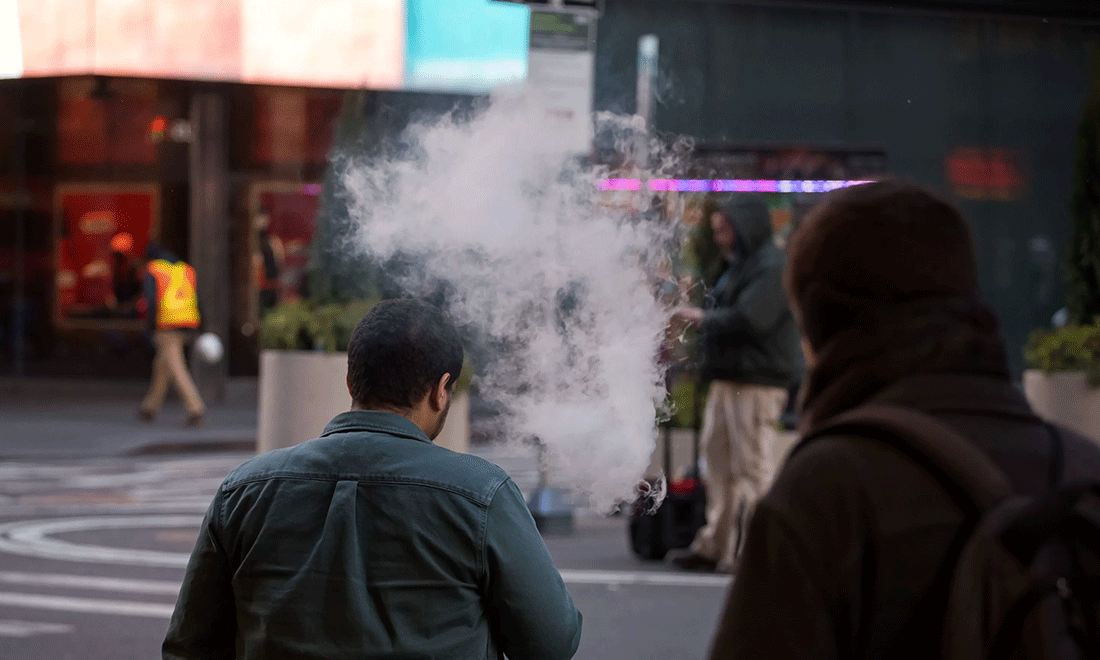 圖片來源:MICHAEL NAGLE/BLOOMBERG VIA GETTY IMAGES
圖片來源:MICHAEL NAGLE/BLOOMBERG VIA GETTY IMAGES美國政府周四報(bào)告稱,,今年使用電子煙的高中生人數(shù)減少了,。
在一項(xiàng)調(diào)查中,10%的高中生表示他們在前一個(gè)月使用過電子煙,,低于去年的14%,。
據(jù)美國疾病控制與預(yù)防中心(Centers for Disease Control and Prevention)報(bào)告,在高中生群體中,香煙和雪茄等其他各種煙草產(chǎn)品的使用率也有所下降,。
南卡羅來納大學(xué)(University of South Carolina)的研究人員肯尼思?邁克爾?卡明斯(Kenneth Michael Cummings)(其并未參與上述研究)說:“我認(rèn)為,,有很多好消息?!?/p>
在中學(xué)生群體中,,約5%的人表示使用了電子煙,這與去年的調(diào)查結(jié)果相差不大,。
今年的調(diào)查訪問了2.2萬多名學(xué)生,,他們都在去年春天填寫過一份在線問卷。該機(jī)構(gòu)認(rèn)為這項(xiàng)年度調(diào)查是評估青少年吸煙趨勢的最佳依據(jù),。
為何高中生的吸煙率出現(xiàn)了下降,?衛(wèi)生官員認(rèn)為,許多因素可能都發(fā)揮了作用,,如提高煙草產(chǎn)品價(jià)格和限制對向成年人銷售煙草產(chǎn)品等舉措,。
目前,美國食品藥品監(jiān)督管理局已經(jīng)批準(zhǔn)了一些煙草口味電子煙的發(fā)售,,旨在幫助成年吸煙者降低吸煙率,。在全美范圍內(nèi),煙草產(chǎn)品銷售的年齡限制為21歲,。
該報(bào)告中的其他主要發(fā)現(xiàn):
目前使用電子煙的學(xué)生中,,約四分之一的人表示每天都會(huì)使用。
約十分之一的中學(xué)生和高中生(也就是280萬名美國未成年人)表示最近使用過煙草產(chǎn)品,。
電子煙是最常使用的煙草產(chǎn)品,,而一次性電子煙在青少年中最受歡迎。
使用電子煙的學(xué)生中,,近90%的人使用的是調(diào)味電子煙,,其中水果和糖果口味的人氣最高。
過去三年里,,聯(lián)邦和各的法律法規(guī)已經(jīng)對幾乎所有青少年偏好口味的煙彈式電子煙小煙(如Juul)實(shí)施禁售,。
不過,美國食品藥品監(jiān)督管理局仍在努力監(jiān)管著龐大的電子煙市場,,目前市面上出售的有數(shù)百個(gè)帶口味(如小熊軟糖和西瓜口味)的電子煙品牌,。調(diào)味電子煙的種類之所以越來越豐富,幾乎完全是因進(jìn)口自中國的廉價(jià)一次性電子煙的熱潮所致,,而美國食品藥品監(jiān)督管理局認(rèn)為那些商品是不合法的,。
美國疾病控制與預(yù)防中心強(qiáng)調(diào)了該報(bào)告中一個(gè)令人擔(dān)憂而又費(fèi)解的發(fā)現(xiàn)。上個(gè)月至少使用過一次煙草產(chǎn)品的中學(xué)生人數(shù)略有增加,,而同樣如此的高中生人數(shù)卻減少了,。美國北卡羅來納大學(xué)(University of North Carolina)的研究人員庫爾特·里比斯?fàn)枺↘urt Ribisl)說,,通常情況下,,這兩組數(shù)據(jù)是同步變化的,。他和卡明斯告誡大家不用過分關(guān)注這一發(fā)現(xiàn),稱這很可能是今年的暫時(shí)現(xiàn)象,。(財(cái)富中文網(wǎng))
佩龍(Perrone)在華盛頓報(bào)道,。
美聯(lián)社健康與科學(xué)部(Associated Press Health and Science Department)得到了霍華德·休斯醫(yī)學(xué)研究所科學(xué)與教育媒體組(Howard Hughes Medical Institute’s Science and Educational Media Group)的支持。美聯(lián)社對本文所有內(nèi)容全權(quán)負(fù)責(zé),。
譯者:中慧言-劉嘉歡
美國政府周四報(bào)告稱,,今年使用電子煙的高中生人數(shù)減少了。
在一項(xiàng)調(diào)查中,,10%的高中生表示他們在前一個(gè)月使用過電子煙,,低于去年的14%。
據(jù)美國疾病控制與預(yù)防中心(Centers for Disease Control and Prevention)報(bào)告,,在高中生群體中,,香煙和雪茄等其他各種煙草產(chǎn)品的使用率也有所下降。
南卡羅來納大學(xué)(University of South Carolina)的研究人員肯尼思?邁克爾?卡明斯(Kenneth Michael Cummings)(其并未參與上述研究)說:“我認(rèn)為,,有很多好消息,。”
在中學(xué)生群體中,,約5%的人表示使用了電子煙,,這與去年的調(diào)查結(jié)果相差不大。
今年的調(diào)查訪問了2.2萬多名學(xué)生,,他們都在去年春天填寫過一份在線問卷,。該機(jī)構(gòu)認(rèn)為這項(xiàng)年度調(diào)查是評估青少年吸煙趨勢的最佳依據(jù)。
為何高中生的吸煙率出現(xiàn)了下降,?衛(wèi)生官員認(rèn)為,,許多因素可能都發(fā)揮了作用,如提高煙草產(chǎn)品價(jià)格和限制對向成年人銷售煙草產(chǎn)品等舉措,。
目前,,美國食品藥品監(jiān)督管理局已經(jīng)批準(zhǔn)了一些煙草口味電子煙的發(fā)售,旨在幫助成年吸煙者降低吸煙率,。在全美范圍內(nèi),,煙草產(chǎn)品銷售的年齡限制為21歲。
該報(bào)告中的其他主要發(fā)現(xiàn):
目前使用電子煙的學(xué)生中,,約四分之一的人表示每天都會(huì)使用,。
約十分之一的中學(xué)生和高中生(也就是280萬名美國未成年人)表示最近使用過煙草產(chǎn)品。
電子煙是最常使用的煙草產(chǎn)品,,而一次性電子煙在青少年中最受歡迎,。
使用電子煙的學(xué)生中,,近90%的人使用的是調(diào)味電子煙,其中水果和糖果口味的人氣最高,。
過去三年里,,聯(lián)邦和各的法律法規(guī)已經(jīng)對幾乎所有青少年偏好口味的煙彈式電子煙小煙(如Juul)實(shí)施禁售。
不過,,美國食品藥品監(jiān)督管理局仍在努力監(jiān)管著龐大的電子煙市場,,目前市面上出售的有數(shù)百個(gè)帶口味(如小熊軟糖和西瓜口味)的電子煙品牌。調(diào)味電子煙的種類之所以越來越豐富,,幾乎完全是因進(jìn)口自中國的廉價(jià)一次性電子煙的熱潮所致,,而美國食品藥品監(jiān)督管理局認(rèn)為那些商品是不合法的。
美國疾病控制與預(yù)防中心強(qiáng)調(diào)了該報(bào)告中一個(gè)令人擔(dān)憂而又費(fèi)解的發(fā)現(xiàn),。上個(gè)月至少使用過一次煙草產(chǎn)品的中學(xué)生人數(shù)略有增加,,而同樣如此的高中生人數(shù)卻減少了。美國北卡羅來納大學(xué)(University of North Carolina)的研究人員庫爾特·里比斯?fàn)枺↘urt Ribisl)說,,通常情況下,,這兩組數(shù)據(jù)是同步變化的。他和卡明斯告誡大家不用過分關(guān)注這一發(fā)現(xiàn),,稱這很可能是今年的暫時(shí)現(xiàn)象,。(財(cái)富中文網(wǎng))
佩龍(Perrone)在華盛頓報(bào)道。
美聯(lián)社健康與科學(xué)部(Associated Press Health and Science Department)得到了霍華德·休斯醫(yī)學(xué)研究所科學(xué)與教育媒體組(Howard Hughes Medical Institute’s Science and Educational Media Group)的支持,。美聯(lián)社對本文所有內(nèi)容全權(quán)負(fù)責(zé),。
譯者:中慧言-劉嘉歡
Fewer high school students are vaping this year, the government reported Thursday.
In a survey, 10% of high school students said they had used electronic cigarettes in the previous month, down from 14% last year.
Use of any tobacco product— including cigarettes and cigars — also fell among high schoolers, according to the Centers for Disease Control and Prevention report.
“A lot of good news, I’d say,” said Kenneth Michael Cummings, a University of South Carolina researcher who was not involved in the CDC study.
Among middle school student, about 5% said they used e-cigarettes. That did not significantly change from last year’s survey.
This year’s survey involved more than 22,000 students who filled out an online questionnaire last spring. The agency considers the annual survey to be its best measure of youth smoking trends.
Why the drop among high schoolers? Health officials believe a number of factors could be helping, including efforts to raise prices and limit sales to kids.
The Food and Drug Administration has authorized a few tobacco-flavored e-cigarettes intended to help adult smokers cut back. The age limit for sales is 21 nationwide.
Other key findings in the report:
— Among students who currently use e-cigarettes, about a quarter said they use them every day.
— About 1 in 10 middle and high school students said they recently had used a tobacco product. That translates to 2.8 million U.S. kids.
— E-cigarettes were the most commonly used kind of tobacco product, and disposable ones were the most popular with teens.
— Nearly 90% of the students who vape used flavored products, with fruit and candy flavors topping the list.
In the last three years, federal and state laws and regulations have banned nearly all teen-preferred flavors from small, cartridge-based e-cigarettes, like Juul.
But the FDA has still struggled to regulate the sprawling vaping landscape, which now includes hundreds of brands sold in flavors like gummy bear and watermelon. The growing variety of flavored vapes has been almost entirely driven by a wave of cheap, disposable devices imported from China, which the FDA considers illegal.
The CDC highlighted one worrisome but puzzling finding from the report. There was a slight increase in middle schools students who said they had used at least one tobacco product in the past month, while that rate fell among high school students. Usually those move in tandem, said Kurt Ribisl, a University of North Carolina researcher. He and Cummings cautioned against making too much of the finding, saying it might be a one-year blip.
___
Perrone reported from Washington.
___
The Associated Press Health and Science Department receives support from the Howard Hughes Medical Institute’s Science and Educational Media Group. The AP is solely responsible for all content.






